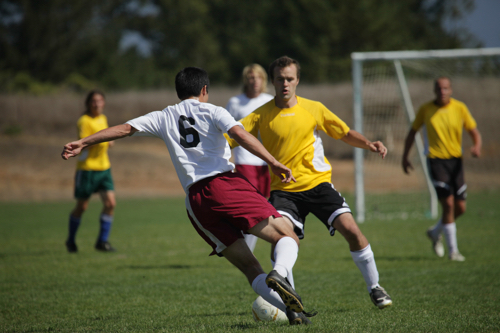Campus News
Intercollegiate athletics program charts course into the future
The NCAA Division III program, which has been under a budget cloud for the past several years, can now confidently look toward the future. The program has been bolstered by a new student fee, was recently restructured so it aligns with other successful Division III programs in the nation, and will head into the coming season with more awareness than ever before.

The UC Santa Cruz intercollegiate athletics program is playing the long game.
The NCAA Division III program, which has been under a budget cloud for the past several years, can now confidently look toward the future. The program has been bolstered by a new student fee, was recently restructured so it aligns with other successful Division III programs in the nation, and will head into the coming season with more awareness than ever before.
“This is a historic moment for Banana Slugs,” said Andrea Willer, executive director of OPERS. “Our NCAA program has more support than ever before. People are engaged and eager to watch this program as it begins a new chapter.”
The NCAA program, established in 1980, consists of 15 men and women’s teams, which have about 270 students on the rosters. The average GPA well exceeds the campus average and the program has boasted a 100 percent academic retention rate for the past five years. The teams have gone on to compete in championships and students have received scholar-athlete honors.
Until recently, the intercollegiate program was at a crossroads. Campus leaders asked that the program develop a new way to fund itself so that it was less reliant on core campus funds, which are needed to support the academic mission of the university.
Students in May backed a $38.50-per-quarter fee that will provide the program with a new revenue source and time to better develop other revenue streams.
The approved fee was significantly less than what had been previously proposed—and didn’t gain support. As a result, the intercollegiate athletics program developed a new, sustainable business model that could provide a roadmap forward. The model calls for a structure that is based off other NCAA Division III programs without football and also seeks to grow revenue through other channels.
The fee this year will generate about $1.1 million, just under half of its $2.3 million budget for the coming year. The remaining funding will come from a campus commitment of $500,000, ticket sales, fundraising, summer campus, and sponsorships of about $300,000; and a five-year apparel contract with Under Armour, the only Division III program with such a deal.
To strengthen the program while also managing costs, the campus made several changes:
- Head coaches have three-year contracts with full benefits and a 3 percent salary increase above last year’s salaries. The campus will spend $622,203 (fiscal year 2018) on head coach salaries, an increase over last year which puts it above the NCAA D-III median of $449,763 (fiscal year 2016).
- All head coaches have 100 percent appointments and will be able to teach physical education and run summer camps,
- Assistant coaches will work under six-month contracts with benefits, and the campus added another assistant coach for track and field, bringing the total number of assistant coaches to 11.
Many of the changes—such as higher salaries for head coaches—have been welcomed, Willer said. Still, she acknowledged other changes—such as seeking new coaches for two sports—have caused confusion and frustration with some athletes and coaches. She’s been meeting with coaches and teams to explain the changes and listen to their concerns.
“Change can be hard, but I know we will be a stronger program in the long run,” Willer said.
The focus now is on recruiting coaches for swimming, women’s soccer, and cross country. The jobs were posted July 10, and the campus expects to have the spots filled in August. Players will serve on the hiring committee to review the candidates. In the 2017-18 year, Willer plans to hire a new athletics director.
“I will look to the head coaches to inform the best strategy and timing for hiring a new athletics director to ensure we can generate the best pool of candidates possible,” Willer said.
A major component of the new business model is to steadily reduce the reliance on the student fee, which is set to expire in spring 2042. The program will need to gradually increase the amount of fundraising, ticket sales, and summer camp revenue to grow the budget.
“We are excited to usher in a new era for Slug athletics,” said men’s basketball head coach Ron DuBois. “As a coach it feels great to have been shown this overwhelming support from the students and administration.
“We have so many positives here at UCSC and now our program is competitively positioned for the future.”
For the first time, the athletic program will have a staff member who will help with fundraising. Without any dedicated help, the program typically has been able to fundraise about $200,000 in outside support. That figure is expected to grow with the added support.
The campus also signed an agreement with Under Armour to provide team uniforms and other financial support.
“Students have shown us that they want to see intercollegiate athletics at UC Santa Cruz,” Willer said. “Now, it’s up to us to follow this model so that we can build the best program for our campus.”